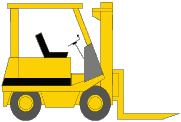
THE RIGHT TIRES FOR YOUR LIFT TRUCK.


Counter-balance lift truck tires are one of those under-rated products everyone takes for granted. Yet for the informed user, they represent a way to upgrade your truck's performance at relatively little cost. The key is understanding what your tire and tire supplier can do for you. For lift trucks there are two or three broad categories of tires, but your decision should depend on where the lift truck will operate. The first common tire type is a solid or press-on tire, which is built around a solid band and 'pressed' onto the hub or rim of the lift truck. These are most often used indoors. For outdoor use, we most commonly use air-filled or 'pneumatic' tires. There are some exceptions. For outdoor applications with a relatively smooth surface (e.g. asphalt) and a high hazard of flats (e.g. metal scrap yard), there are some specialty solid tires. In these situations, however, it's important to remember old man winter's ice and snow. Similarly, if your indoor facility doesn't have a concrete floor, you may want to look at this issue more closely, starting with type of tire tread and profile. For proper tire selection for outdoor uses, your key objectives is to get the most rubber in contact with the most road. Compared to the solid tire, an air-filled or pneumatic tire provides the following benefits: Greater ground clearance. Air better absorbs shock transfer. Allows more surface contact on uneven ground because of the greater give. But compared to the solid tire, one of the biggest disadvantages of an air-filled tire can be summarized in a single word: flats. To cope with this issue, the tire industry has come up with at least two alternative types of flat-proof tires. The first is a urethane-filled product in which the inner tire is filled with a urethane foam compound. The second is a solid tire sometimes called a 'resilient' tire, which resembles a pneumatic tire. The most important thing to consider when it comes to pneumatic tire maintenance is simple: proper air pressure. It's recommended you check the pressure weekly with a tire gauge when the tire is cold (at least three to four hours since the last use.) Another practical tip for really big trucks with dual tires is to remove stones and debris between the threads. Otherwise, inspect for excessive wear or damage and replace when needed. This step is also useful when considering retreading or rebuilding--a viable and economic strategy, particularly for large, specialty pneumatic tires. There are a variety of solid tires available for indoor use. From a shape viewpoint they can be classified in the following ways: Tread surface: Smooth or non-skid (lugged). Lugged tires are used for rough surfaces or for combinations of indoor/ outdoor applications where grip is important. However, they're more prone to chipping and chunking. Profile: Some common profiles include low profile (for high stability), wide profile (for better load distribution) and regular profile tires, used for standard applications. Generally, it's best to go back to the basic tire made of natural or synthetic rubber and compounds such as 'carbon black', which provide the dark colour. The most common is the non-marking type made of polyurethane. Polyurethane tires are used for high-load applications in which an energy-efficient or non-marking tires are desired. The biggest negative to polyurethane tires is their lack of give, which can create a rough ride for the driver and load, particularly if the surface isn't smooth. Suppliers may offer rubber non-marking tires but these tend to wear more quickly, with an effect comparable to a pencil eraser. Non-marking tires, in general, are only effective if the floor is properly scrubbed. If the floor is already marked up, the rubber marking will transfer to the non-marking tire. Regardless of what you choose, you should always keep tire maintenance and care in mind. Lift truck tires should be replaced in the following situations: A maximum wear of five centimetres (two inches) from the original diameter. Abnormal splitting from the inner band. Excessive cutting and chunking (that can cause a lift truck to jump when you go forward or reverse). Excessive wear on one tire (caused by continuous turns in the same direction). For companies with larger fleets of about 15 to 20 trucks there are specialized preventive maintenance inspection programs offered by major tire suppliers. Contact your supplier for details. Tires are an important feature to consider when buying a lift truck. They also provide a cheap way to improve your truck performance.
 |